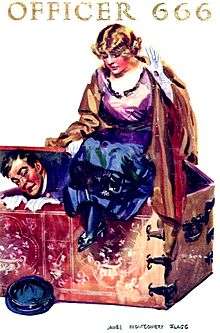Officer 666 (1916 film)
Officer 666 is a 1916 silent film made in Australia, based on a successful Broadway comedy of 1912. The film was directed by Fred Niblo who would go on to direct The Mark of Zorro, The Three Musketeers, Blood and Sand and over forty more films.
| Officer 666 | |
|---|---|
 1912 poster for George M. Cohan's stage production of the play | |
| Directed by | Fred Niblo |
| Written by | W. J. Lincoln |
| Based on | Played by Augustin MacHugh Adapted by George M. Cohan |
| Starring | Fred Niblo Enid Bennett George Bryant Marion Marcus Clarke |
| Cinematography | Maurice Bertel |
Production company | J.C. Williamson Ltd |
Release date | 1 April 1916[1] |
Running time | 40 minutes |
| Country | Australia |
| Language | English |

Plot
In New York, millionaire Travers Gladwin (Fred Niblo) learns of a plot to steal his collection of paintings by some art criminals led by Alfred Wilson (Sydney Stirling). Gladwin pretends to leave to go on holiday, but actually remains in the area disguised as a policeman. Wilson and his gang arrive, with Wilson posing as Gladwin, and a young lady as his fiancee. Gladwin tries to stop the robbery but eventually lets Wilson go in order to save the honour of the young lady.
Cast
- Fred Niblo as Travers Gladwin
- Enid Bennett as Helen Burton
- Marion Marcus Clarke as Mrs Burton
- Sydney Stirling as Alfred Wilson
- Maurice Dudley as Watkins
- Henry Matsumoto as Bateato
- Pirie Bush as Whitney Barnes
- Edwin Lester as Detective Kearney
- George Bryant as Captain Stone
- Matee Brown as Sadie
- Reine Connelly as Celeste
Original play
The film is an adaptation of Augustin MacHugh's 1912 comedy play which was produced on Broadway by George M. Cohan and Sam Harris, then toured the United States during 1912 and 1913.[2][3] Niblo toured with the play in Australia in 1912-13. The play was based on the 1912 novel by Barton Currie and Augustin MacHugh.
The play was also filmed in 1914 and 1920.
Production
The movie was shot shortly after Get-Rich-Quick Wallingford (1916) and was completed shortly before Niblo returned to America in June 1915.[4] It was mostly shot at J. C. Williamson's film studio in Melbourne with some location work.[5][6]
Reception
Although completed by late May 1915 the film was not released until nearly a year later. It was not a success at the box office.[4]
The Sunday Times called it "a happy piece of farce acting, cleverly photo graphed, and excellent in its sustained fun"[7] and "the most successful [picture] that has been issued from the Williamson studios."[8]
The Moving Picture World called it "a very fine comedy, and one of the best produced in this country. Fred Niblo still retains his great personality on the screen."[9]
Unlike most Australian silent movies, some of it survives, and the original print is located at the National Screen and Sound Archive in Canberra, Australia.
Notes
- "Advertising". The Sydney Morning Herald. National Library of Australia. 5 April 1916. p. 2. Retrieved 19 April 2012.
- Google books
- NY Times article
- Andrew Pike and Ross Cooper, Australian Film 1900–1977: A Guide to Feature Film Production, Melbourne: Oxford University Press, 1998, p61
- Marsden, Ralph. 'The Old Tin Shed in Exhibition Street': The J.C. Williamson Studio, Melbourne's Forgotten Film Factory [online]. Metro Magazine: Media & Education Magazine, No. 157, 2008: 144-153. Availability: <http://search.informit.com.au/documentSummary;dn=519108300276483;res=IELAPA> ISSN 0312-2654. [cited 15 Nov 14].
- When J.C Williamson Ltd Made pictures, Everyones Ltd, 16 December 1925, p. 28, retrieved 27 April 2019
- "TWO FEATURES AT ROYAL". The Sunday Times. Sydney: National Library of Australia. 2 April 1916. p. 6. Retrieved 15 November 2014.
- "ROYAL GOSSIP". The Sunday Times. Sydney: National Library of Australia. 2 April 1916. p. 10. Retrieved 15 November 2014.
- Tom Imrie, "Australian Notes", Moving Picture World 5 April 1916 accessed 23 November 2014